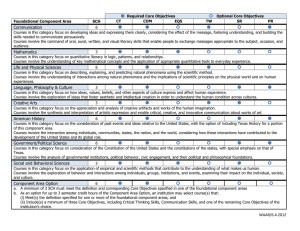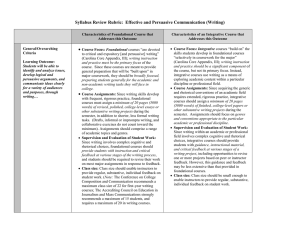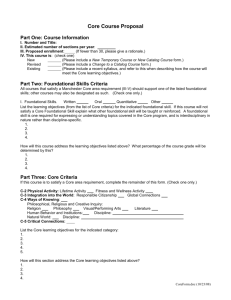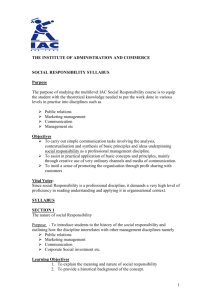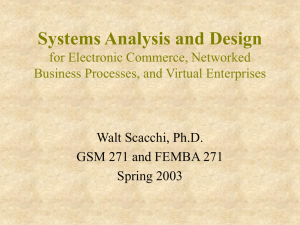Syllabus Review Rubric: Learning Outcome: Note:
advertisement
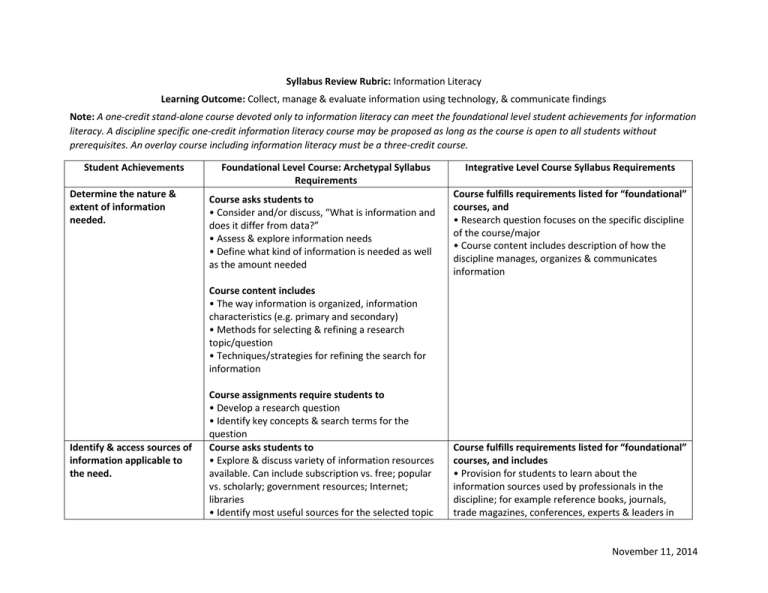
Syllabus Review Rubric: Information Literacy Learning Outcome: Collect, manage & evaluate information using technology, & communicate findings Note: A one-credit stand-alone course devoted only to information literacy can meet the foundational level student achievements for information literacy. A discipline specific one-credit information literacy course may be proposed as long as the course is open to all students without prerequisites. An overlay course including information literacy must be a three-credit course. Student Achievements Determine the nature & extent of information needed. Foundational Level Course: Archetypal Syllabus Requirements Course asks students to • Consider and/or discuss, “What is information and does it differ from data?” • Assess & explore information needs • Define what kind of information is needed as well as the amount needed Integrative Level Course Syllabus Requirements Course fulfills requirements listed for “foundational” courses, and • Research question focuses on the specific discipline of the course/major • Course content includes description of how the discipline manages, organizes & communicates information Course content includes • The way information is organized, information characteristics (e.g. primary and secondary) • Methods for selecting & refining a research topic/question • Techniques/strategies for refining the search for information Identify & access sources of information applicable to the need. Course assignments require students to • Develop a research question • Identify key concepts & search terms for the question Course asks students to • Explore & discuss variety of information resources available. Can include subscription vs. free; popular vs. scholarly; government resources; Internet; libraries • Identify most useful sources for the selected topic Course fulfills requirements listed for “foundational” courses, and includes • Provision for students to learn about the information sources used by professionals in the discipline; for example reference books, journals, trade magazines, conferences, experts & leaders in November 11, 2014 Course content includes • Introduction to the resources available from University Libraries • Other available resources • Search basics for library catalog, article databases, Internet search engines, and/or other appropriate resources the field, authoritative websites, government resources, white papers, etc. • Students use resources specific to the discipline • Advanced search techniques for the library catalog, article databases, Internet search engines, and/or other appropriate resources Course assignments require students to • Select resources to be used • Collect information from their selected resources Evaluate information & its sources for credibility, reliability, point of view or objectivity, & currency. Course asks students to • Analyze information sources selected and/or rejected in order to assess the reliability, accuracy and quality of information Course content includes • How to evaluate information & information sources for credibility, reliability, point of view or objectivity & currency Course fulfills requirements listed for “foundational” courses, and also requires students to • Evaluate information & sources from the perspective of the discipline • Examine & compare information from various sources to evaluate reliability, validity, accuracy, authority, timeliness, & point of view or objectivity; systematically & methodically analyze all points of view Course assignments require students to • Evaluate information & sources for reliability based on author, objectivity or point of view, timeliness, coverage • Use reliable information sources that are relevant to the question chosen Employ appropriate conventions for integrating Course asks students to Course fulfills requirements listed for “foundational” courses, and also requires students to November 11, 2014 & citing sources ethically & legally. • Consider & respect the intellectual property rights of those who create the information/knowledge they are using • Use citations & references required by the discipline & in the format/style required by the discipline Course content includes • How to properly cite sources of information • Introduction to the concept of academic honesty. Can include definition of types of plagiarism, copyright, fair use, paraphrasing, quoting, distinguishing between common knowledge & ideas requiring attribution • An acceptable style guide for the assignment Course assignments require students to • Correctly use citations & references • Demonstrate a basic understanding of the ethical & legal restrictions of the use of information, i.e. gives credit to sources & authors Use, manage, & communicate information using appropriate technology to accomplish a specific purpose. Course asks students to • Consider & discuss how information is disseminated Course content includes • Explanations of software &/or other technology preferred by the professor for managing & presenting projects & communicating findings Course assignments require students to • Use available online & print resources to gather information for an annotated bibliography, research paper, oral presentation or other Course fulfills requirements listed for “foundational” courses, and requires students to • Expand search for discipline specific materials beyond local holdings, for example use Interlibrary Loan service &/or include a variety of formats such as oral histories, video, web based resources, primary vs. secondary, etc. • Investigate subscription based resources to which the university subscribes • Explore advanced search features in search engines to increase relevant search results November 11, 2014 assignment • Articulate & present findings in a logical & cohesive manner using appropriate technology as defined by the professor November 11, 2014

